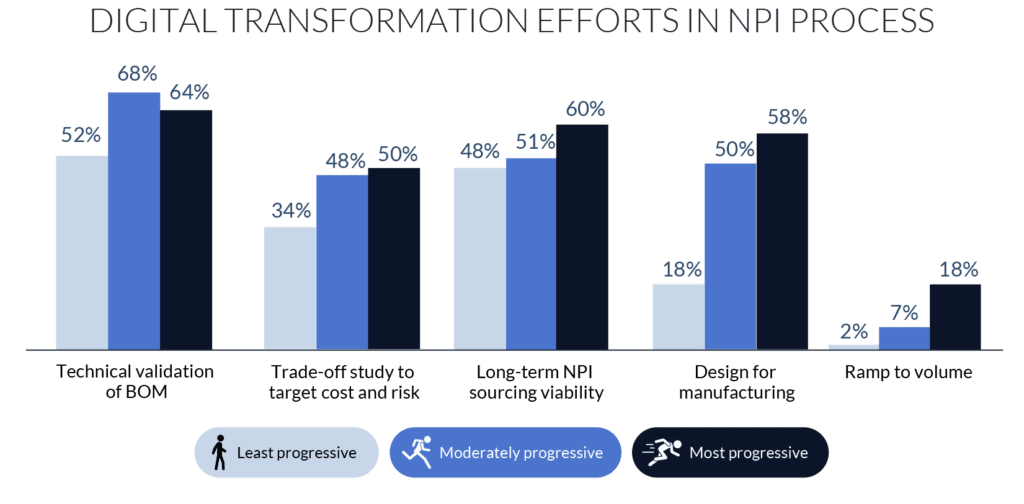- Solutions
ENTERPRISE SOLUTIONS
Infuse new product development with real-time intelligenceEnable the continuous optimization of direct materials sourcingOptimize quote responses to increase margins.DIGITAL CUSTOMER ENGAGEMENT
Drive your procurement strategy with predictive commodity forecasts.Gain visibility into design and sourcing activity on a global scale.Reach a worldwide network of electronics industry professionals.SOLUTIONS FOR
Smarter decisions start with a better BOMRethink your approach to strategic sourcingExecute powerful strategies faster than ever - Industries

Compare your last six months of component costs to market and contracted pricing.

- Platform
- Why Supplyframe
- Resources
Editor’s Note: This is the fourth article in a series discussing the findings from a NPI and Sourcing Study, done in partnership with Lifecycle Insights. The content below was produced by Lifecycle Insights. Click here to see the series overview.
To account for differences in performance, Lifecycle Insights looked at the strategic initiatives the three respondent cohorts had pursued to improve the NPI process. Thanks to those initiatives, the most progressive organizations did better than the least progressive in launching and delivering products on time while satisfying NPI criteria.
This section will discuss the strategic initiatives that make a difference in managing complexity and the NPI process. They include the length of time that organizations have invested in NPI DX initiatives and the breadth of those efforts.
Length of Investment in an NPI DX Initiative
Lifecycle Insights assessed how long the most progressive organizations had invested in DX initiatives for NPI. This is one of the most significant areas of analysis in the study. It forms the basis for recommendations on how other companies should proceed with their own improvements. The study findings illustrated stark differences in this area between the most progressive organizations and the least progressive ones.

Figure 3: Compared to the least progressive, the most progressive have completed more aspects of their DX for NPI initiatives, have been implementing them for a longer period, and expect to continue those improvement efforts for far longer.
One area of differentiation that stands out is the current state of a company’s DX initiatives for NPI. It is very common for such initiatives to be broken into progressive stages. Forty-two percent of the most progressive organizations have completed at least one phase of their DX initiatives. Compare that to 32% of the moderately progressive organizations and none of the least progressive. In addition, 56% of the most progressive organizations report pursuing DX efforts for NPI improvement for three years. Only 7.5% of the moderately progressive and, again, 0% of the least progressive respondents say the same.
These findings show how the most progressive organizations are succeeding. Their DX for NPI initiatives are far more mature, and are already yielding benefits. It’s clear those efforts are making a tangible impact on success measures.
It is also worth noting that the most progressive organizations aren’t just checking the box on DX for NPI efforts. Although many of these organizations have been investing in those initiatives for three years, 64% of respondents stated they plan to continue those efforts for more than a year. Another 17% revealed their organizations’ plans to make DX for NPI a continuous improvement effort without an end point. These findings illustrate a significant difference in attitude that affects performance.
Breadth of NPI DX Initiative
Lifecycle Insights was also interested in evaluating the breadth of companies’ efforts, which can range dramatically in scope. One organization may focus tightly on one or two specific areas, while others may make more expansive efforts to improve many subprocesses across the NPI process.

Figure 4: The most progressive include many more aspects of DX for NPI initiatives in their improvement efforts, making them more comprehensive.
Once again, the survey revealed a key difference between the three respondent groups: The most progressive organizations’ initiatives were much broader than those of the least progressive group.
Each major improvement category represents a significant investment on its own. And in each of these areas, at least 10% more of the most progressive have employed these practices than the least progressive. These practices include:
- The ability to technically validate the BOM. This helps organizations verify this key deliverable earlier in the product development process.
- Performing trade studies to look at the cost-versus-risk ratio. This empowers more informed decision-making.
- Assessing long-term sourcing viability. This permits NPI managers to look past the short-term goals of launching and delivering on time to support the bigger picture.
- Taking manufacturability and ramp-to-volume into account. This mitigates more risks that can occur before launch and delivery.
Each of these separate efforts has the potential to improve the NPI process on its own.
Taken together, a combination of these efforts packs a powerful punch that allows the most progressive organizations to satisfy all NPI criteria at higher rates than the other respondent groups. These more expansive efforts do require more work up front, but the most progressive organizations can still hit their launch and delivery dates at a higher clip. The most progressive protect their launch and delivery dates by employing early due diligence around NPI criteria.
In this way, they avoid common issues that result in delays or extra costs, such as a supplier struggling to ramp to volume or a manufacturing problem. It’s clear these kinds of improvements are complementary efforts that help manage risks before they become costly downstream problems.



